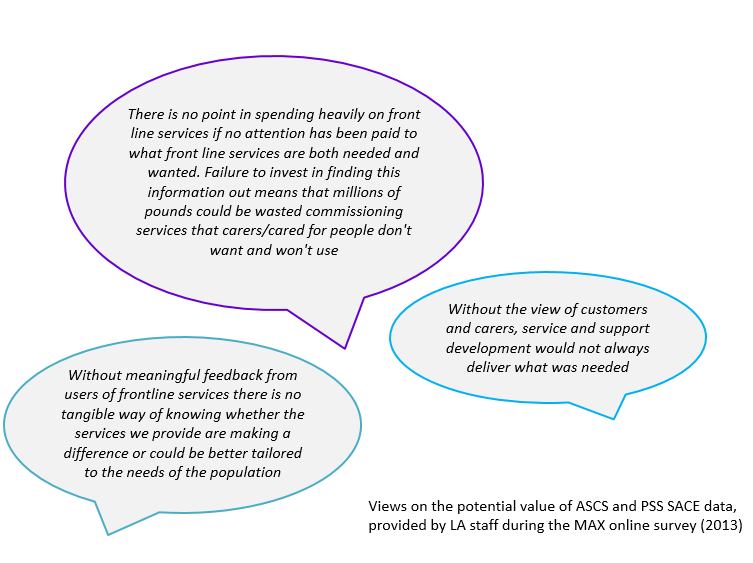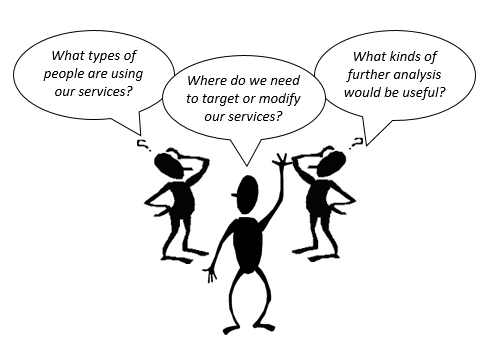GETTING TO KNOW YOUR SERVICE USERS: USING ASCS AND PSS SACE DATA TO BUILD PROFILES
Building personalised and outcomes-focused services and support for adult service users and carers is not an easy task, and the local authority (LA) staff involved in the design and delivery of local services require robust and good quality information to guide their decision-making. In particular, on who their service-users and carers are, and how they feel services are helping them to achieve a better quality of life – or, conversely, if services are not helping, where improvements or additional support are required.
Understanding what matters most to the people who use adult social care services is clearly a priority to LAs and 75 of the 100 staff who completed the earlier MAX online survey stated that their organisation conducted or commissioned local research to fulfil this purpose.
While conducting local surveys and focus groups can provide rich insights into the views of the service users and carers who use services and support – and are a vital part of local research and consultation – are existing sources of useful information being overlooked?
The ASCS and PSS SACE are completed by large and representative samples of adult carers and service users in England, and may be one of the largest – if not, the largest – pieces of local research that your organisation conducts with these groups. Your ASCS and PSS SACE datasets therefore provide you with an invaluable opportunity to really get to know who your service users and carers are, and what they need.
THE ADULT SOCIAL CARE AND CARERS SURVEYS: A POTENTIAL GOLDMINE OF USEFUL INFORMATION FOR LOCAL DECISION-MAKING AND SERVICE IMPROVEMENTS

Many of the LA staff involved in our earlier project activities saw the potential value of using the data collected by the ASCS and PSS SACE to guide the design and delivery of local adult social care services. As outlined in our earlier blogs and reports, however, analysts often struggled to translate this data into meaningful management information.
THE VALUE OF SERVICE USER PROFILES
Profiles are summaries of the key characteristics of a particular person or group of people and are developed by organisations to ensure that the products or services they provide fulfil the needs and preferences of their target (profiled) audience.
Accurate profiles are an essential part of business – as, without them, organisations may fail –and can be more than just a marketing ploy. LA decision-makers wishing to use service user feedback to guide the design and delivery of outcomes-focused services and support (and also the monitoring and evaluation of those services and support), for example, may find tremendous value in service user profiles as these can help them to answer a number of local information needs and/or identify where further analysis or action is required.

BUILDING PROFILES USING ASCS AND PSS SACE DATA
All of the data you need to build a detailed profile is collected by the ASCS or PSS SACE and summarised in the NHS Digital data return. Building a profile therefore involves simply reorganising and summarising the key features of your survey dataset into a more appropriate and meaningful format. Some tips on how to do this are summarised in the box below and further guidance can be found in the EXPLORING ASCS DATA GUIDE and the EXPLORING PSS SACE DATA GUIDE.
| · Rather than summarising the dataset question by question (a common strategy noted in survey reports reviewed previously) aim to answer key questions that may be of potential interest or relevance to decision-makers within your organisation. For example: Who are our carers? Who are they caring for? · Develop a general profile first, based on the entire dataset. This will help you to identify general trends and also where further profiles or analysis would be useful (e.g. older service users etc.,) · Consider using bullet point statements rather than full sentences and avoid summarising what is already apparent in the accompanying table and charts · Use the analysis tools in the MAX toolkit. |
An example of a profile based on PSS SACE data is provided here.
We have written a series of short blogs to help users make the most of the analysis element of the MAX toolkit and transform their ASCS and PSS SACE datasets into meaningful management information.
_________________________________________
Disclaimers
This blog is based on independent research commissioned and funded by the NIHR Policy Research Programme (Maximising the value of survey data in adult social care (MAX) project and MAX toolkit implementation and impact study). The views expressed in the publication are those of the author(s) and not necessarily those of the NHS, the NIHR, the Department of Health and Social Care or its arm’s length bodies or other government departments.
